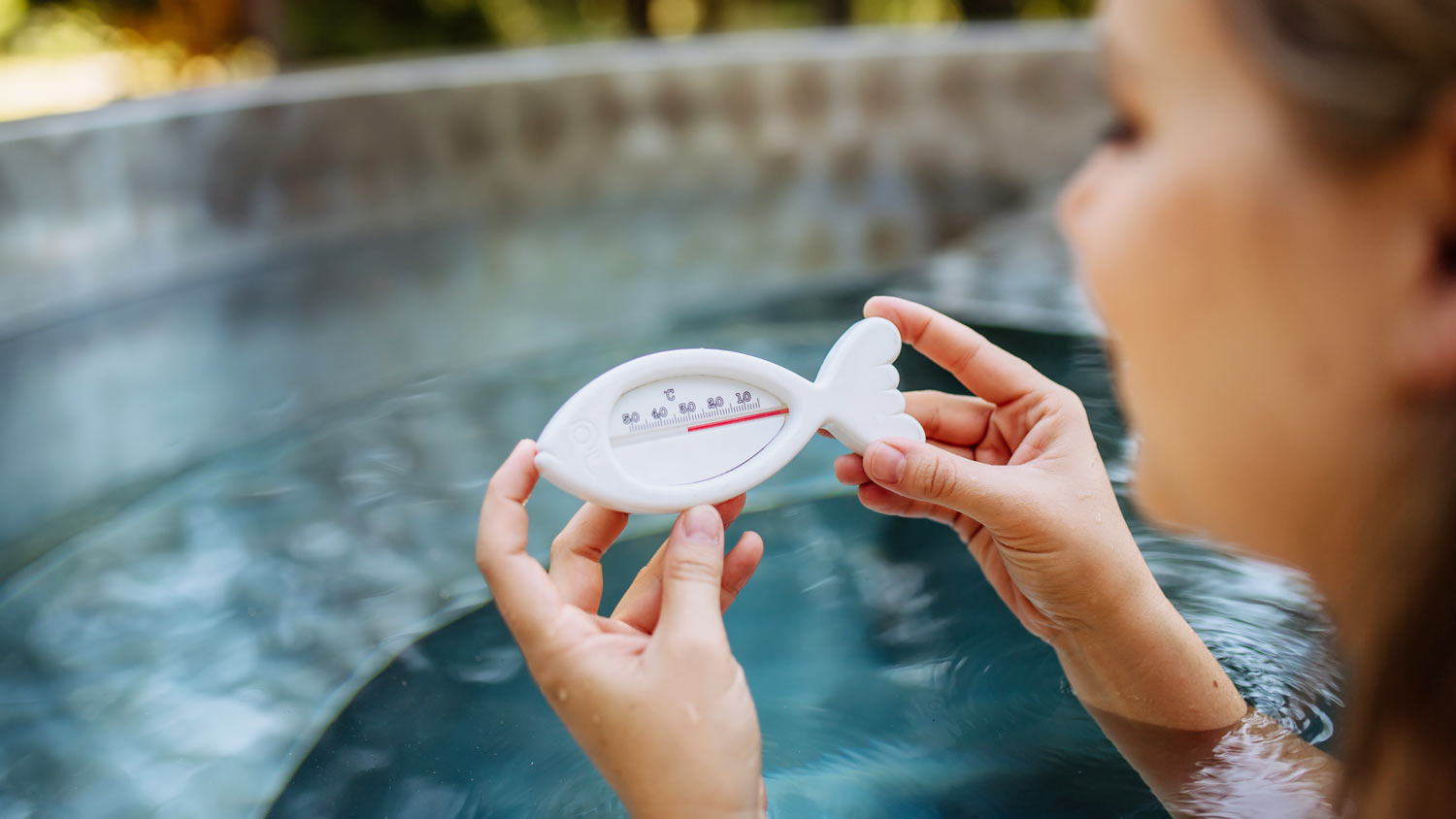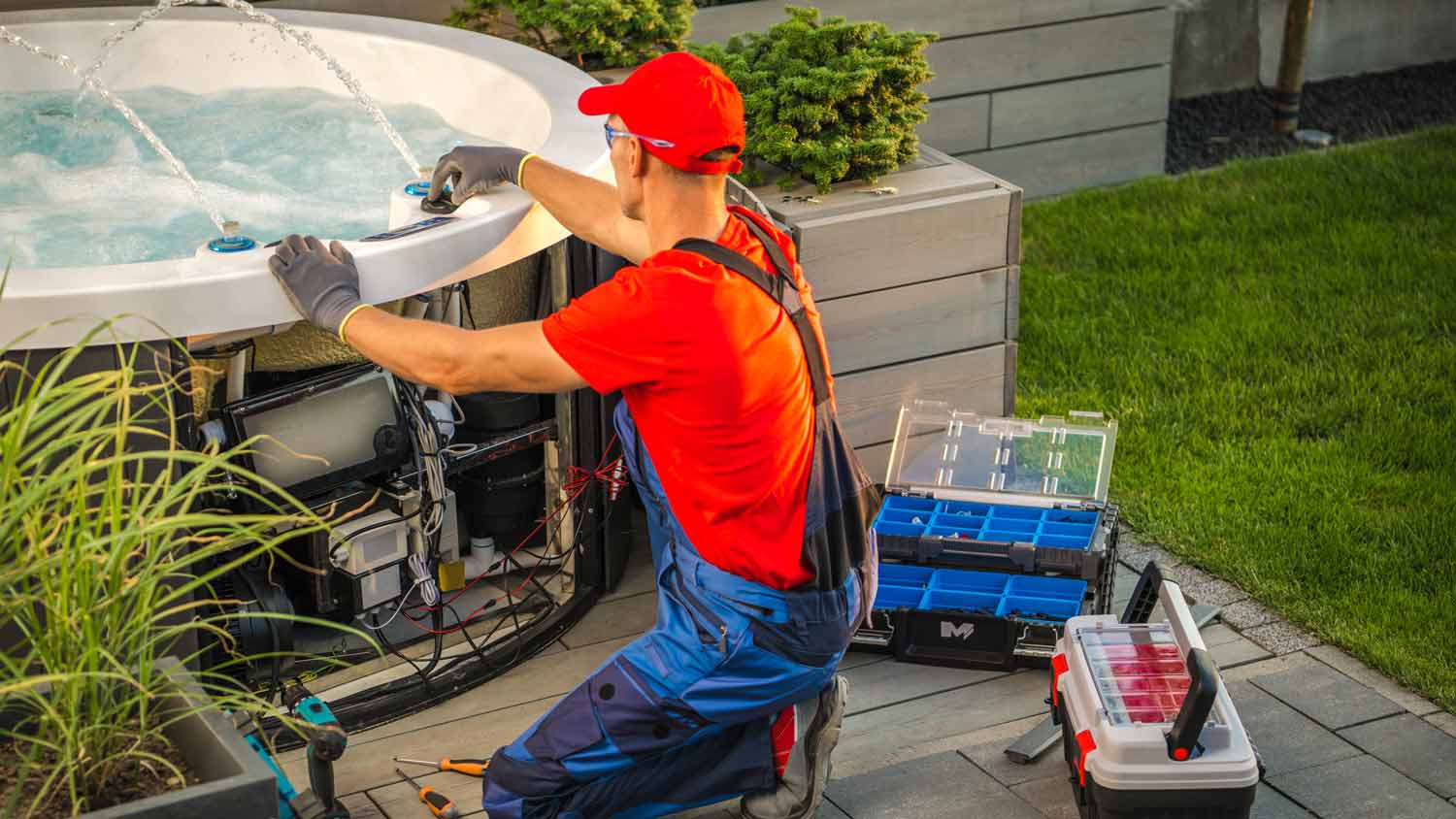Hot Tub Heater Not Working? Here Is What You Can Do
Turn up the heat (again) with these troubleshooting tips


Spa heater problems are often due to low water flow.
The problem could be user error or a mechanical problem.
Conducting regular maintenance can prevent problems with your spa heater.
You were looking forward to a nice hot tub session, but then you realize that the water is lukewarm at best. If your hot tub is not heating up properly, it is easy to assume that you need a new heater; however, there are lots of different reasons why your heater is not working, and many of those possibilities have nothing to do with the heater itself. Read these tips to find out what is really going on.
1. Check the Thermostat and Temperature Sensor

The first thing you should check is the thermostat settings. Someone may have turned down the thermostat without you knowing, which could explain why the water is not hot. Next, manually take the temperature of the hot tub water and compare it to your control panel readings. If the thermostat is registering a different temperature than the actual water temperature, then you may be dealing with either a thermostat or temperature sensor failure. In this scenario, you will need to repair or install a new thermostat and/or temperature sensor.
2. Check the Water Flow
You might not immediately think of low water flow when dealing with a heater that is not working, but it is a common hot tub problem. A heater requires proper water flow to work correctly, so if the water flow is too low, then the heater shuts off. This prevents overheating, damage, and fires. Here are some things to check to troubleshoot this problem.
Clogged Pipes or Spa Drain
Clogged pipes or a clogged spa drain in your hot tub will cause low water flow. You can avoid this by regularly using a hot tub flush before draining and refilling the tub. Depending on the size of your tub and usage, you should drain and clean a hot tub every six weeks to four months.
Clogged Filters
One of the common causes of low water flow in a hot tub is clogged filters. This usually happens if you forget to check and clean the filter on a regular schedule. Besides causing low water flow, a clogged filter will make it harder for you to maintain and balance the water.
Check your filter every two weeks and clean it every month as part of your hot tub maintenance schedule. Every two to three months, soak the filter overnight. If the filter is too dirty, you should get a new one. The water flow should return to normal once you fix the clogged filter.
Closed Valves
If you recently did work on your hot tub, you may have accidentally closed a valve, or you may have a partially closed valve. Check the valves and make sure they are all in the correct open or closed position.
Too Many Closed Jets
It may not seem like a big deal to close some jets on your hot tub, but this can cause water flow problems. Instead of closing the water jets, you should change the jet intensity levels. Open up your jets again and the water flow may go back to normal.
Low Water Levels
Hot tub water levels can get too low from evaporation in both hot and cold weather. If your water levels are too low, then the pumps circulate too much air into the system. This can cause the heater to shut down. To fix this, fill your tub to the correct level. Balance and sanitize the water, then reset the heater.
Clogged or Broken Pump Impeller
As the pump circulates the water in your spa, debris can get stuck in the pump impeller. If you do not fix the clog, it can eventually break the impeller. Clear out the clog if you find one, and if the impeller is broken, replace it with a new one.
Broken Pump
A broken pump will not circulate the water in your tub. Oftentimes, a broken pump is due to a bad motor or worn-out seals. If that is the case, you will need a replacement motor or seals. Otherwise, you may need a new pump.
3. Check the Heater Element

The heater element is what heats the water. If an element goes out, then your heater will not work anymore. Check if your heater element is drawing power with a multimeter and amp meter. Note that you should not attempt to diagnose a heater element unless you have extensive experience doing electrical troubleshooting and repair. Otherwise, call a hot tub repair company near you.
There is also a chance that your heater element has scale buildup if you have hard water. To clean your element, you will need to flush the system. As a preventative measure, do this twice a year.
Sometimes, if there is a heater failure, you can have a dry fire. This happens if the heater runs with little to no water flow and the heater overheats. If this happens, you will need to get a hot tub heater replacement.
Keep in mind that heaters have a lifespan of four to eight years. If you know your heater is nearing the end of its lifespan, look into getting a replacement. Sometimes, your hot tub will not heat up simply because the heater is too old and no longer working.
4. Check Switches
The high limit switch on your heater turns off the heater and pump when the water reaches very high temperatures. In normal circumstances, a spa should not exceed 104 degrees Fahrenheit, but if it reaches 110 to 120 degrees Fahrenheit, the high limit switch will trip and cut the power.
If the high limit switch malfunctions, it can turn the heater off even when it is nowhere near the temperature limits. First, check if your high limit switch was accidentally set to temperatures lower than 110 degrees Fahrenheit. If the settings are correct, you will likely need a replacement switch.
Additionally, the pressure switch monitors water pressure while flow sensors detect the water flow. If either of these does not work properly, then it would trigger the heater to shut down. Furthermore, a properly working pressure switch will pick up on low water pressure due to water supply line clogs, plumbing problems, or water supply valve issues.
5. Look for Corrosion

If the water pH is too low, then your spa equipment can corrode, including the heater. Once a heater gets corroded, there is no way to fix it. You will need a replacement. Sometimes the corrosion happens not only because of low pH but because of high levels of bromine or chloride.
Signs of corrosion on electrical heaters include pitting, leaks, errors on your control panel, and tripped circuits.
6. Check Spa Equipment Door
If you have been doing repairs to your spa and recently removed your equipment access door, you should double-check that you closed the door correctly. Some spa heaters will not work if the door is not closed all the way.
7. Check Heating Mode

If your spa has different heating modes, double-check the heating mode you chose. Usually, there is a heating mode called “ready” or “auto,” during which the heater will turn on any time to maintain the set temperature.
On the other hand, modes called “rest” can limit when the heater turns on. For example, your heater might only kick on during a filter cycle when it is on the “rest” mode; or you might have chosen a “day” mode, which means your heater will only turn on during the day.
So, check your heating mode and make sure it is set to “auto” if you are having a hard time getting your heater to turn on.
8. Clear Air in the Pipes
If your heater was working fine until you drained and refilled your tub, you might have accidentally caused a hot tub airlock. When this happens, your heater can shut down to prevent damage.
Fix the airlock by running the jets on low speed for 10 to 20 seconds, then on high for 10 to 20 seconds. Go back and forth between the low and high speeds until you do not see any air bubbles. If this does not work after three or four tries, call a plumber to help clear the airlock.





- 14 Reasons Your Water Is Only Lukewarm
- 9 Tips for Preventative Maintenance on a Hot Water Heater
- 6 Signs Of Water Heater Failure
- Why Your Hot Water Isn’t Working—And What to Do About It
- Top 7 Signs You Need a New Water Heater
- Top Causes of Water Heater Leaks and What to Do When It Leaks
- Common Reasons Why the Water Heater Keeps Turning Off
- How Long Does a Water Heater Last? Should You Replace It?
- How Long Does It Take to Drain a Water Heater?
- Why the Water Heater Keeps Tripping Breaker










